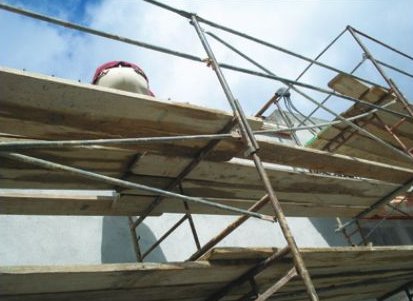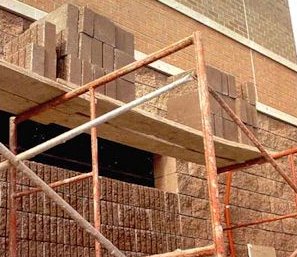Inspecting the Platform
Except when used only as a walkway, the platform is the work area of the scaffold. Therefore, an inspection of a scaffold platform requires safety checks of both the platform structure and how the platform is used by the workers.
Planking
- Make sure each platform is fully planked or decked between the front uprights and the guardrail supports. Platforms used solely as walkways, or during erection or dismantling, require only the planking that the employer establishes is necessary to provide safe working conditions.
- Make sure no gaps greater than 1 inch are permitted between adjacent planks or deck units, or between the platform and the uprights.
- If it can be demonstrated that a wider space is necessary, check to make sure the gap is as small as possible and does not exceed 9 1/2 inches.
- Ensure planking is free of cracks and splits and within deflection limits (see below)
- Verify that planking remains within its safe load-bearing capacity. Make sure the planks are not allowed deflect more than 1/60th of its span between supports. A competent person should monitor deflection.
- Make sure wooden planking is covered with opaque finishes, except that platform edges may be marked for identification. Note: Platforms may be coated periodically with wood preservatives, fire retardants, and slip-resistant finishes, provided they do not obscure the top or bottom wood surfaces.
- Ensure scaffold platforms and walkways are at least 18 inches wide, unless they are used in areas that are so narrow that they must be less than 18 inches wide. In such cases, verify that the platforms are as wide as feasible, and fall protection is provided.
- Make sure that anything that could cause a slip, trip or fall (i.e. tools, scrap material, chemicals, snow, ice, etc.) has not been allowed to accumulate on the platform. For the same reason, cleats or other means of connecting planks should be on the underside.
- Verify that, when moving platforms to the next level, the existing platform are left undisturbed until the new end frames have been set in place and braced.
Knowledge Check Choose the best answer for the question.
2-13. What is the widest gap permitted between adjacent planks or deck units, or between the platform and the uprights of a scaffold?
You forgot to answer the question!


